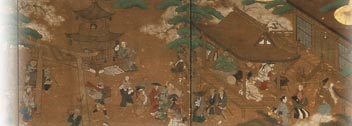International Symposium: “Who Was KANZE Hisao?”
Outline
| date | September 27, 2010 (Monday), 13:30–18:00 |
|---|---|
| Venue | Ono Memorial Hall |
| Organizer | Japanese Theatre Research Course |
| outline | This year is the 33rd anniversary of the death of KANZE Hisao (1925–1978), the brilliant and influential Noh actor who died at the young age of 53. To mark that event we invited speakers who for the most part were colleagues or who had known him at first hand to remember his achievements during a three-part symposium. Despite the rainy weather the symposium was a great success attracting an audience of 350 people. |
Details
Session 1, entitled “The Challenge to Traditional Theatre”, was a discussion of KANZE Hisao as a performer of traditional theatre with talks by the Kyōgen actor and National Treasure NOMURA Mansaku, who took part in numerous innovative performances with KANZE Hisao; Shelley Fenno Quinn, a professor at Ohio State University who after KANZE Hisao’s death interviewed 21 of his associates and made valuable oral recordings of each of them talking about KANZE Hisao; and Noh researcher TAKEMOTO Mikio (program leader) who was acquainted with KANZE Hisao during his undergraduate days. Serving as moderator was OKAMOTO Akira, professor at Meiji Gakuin University and a man of the theatre who had the pleasure of meeting KANZE Hisao with TAKEMOTO. As a starting point of KANZE Hisao’s theatrical experiences there was a discussion of the significance of Moonstruck Pierrot directed by TAKECHI Tetsuji in which NOMURA participated. Further, on KANZE Hisao’s unprecedented and unsurpassed performance theory, which squarely confronted Zeami’s theories of Noh, the observation was made that the reason it has not been passed down to the present is because KANZE Hisao’s premature death prevented him from compiling Zeami’s theories as a performance theory for today’s Noh.Session 2 consisted of a screening with an explanation by OKAMOTO Akira of “The Bases of the Theatrical Process,” a workshop conducted by KANZE Hisao and Jean-Louis Barrault which was filmed by the Société Franco-Japonaise de théatre in 1977; and a talk on the “Art of KANZE Hisao” (TAKEMOTO substituting for YOKOMICHI Mario, professor emeritus at Tokyo University of the Arts who was unable to attend because of illness), which discussed changes in KANZE Hisao’s art by comparing the same utai from “Kinuta” at different times in KANZE Hisao’s career (1969 and 1976). The significance of this session was that it allowed for an empirical analysis of KANZE Hisao’s physical presence.
The three speakers in Session 3, “KANZE Hisao and the Present Day,” were WATANABE Moriaki, University of Tokyo professor emeritus and a professor at Kyoto University of Art and Design as well as a theatre director who brought about a physical transformation in KANZE Hisao through the Mei-no-kai and other projects; composer YUASA Jōji, who undertook a collaboration between Noh and modern music with KANZE Hisao, and inspired KANZE Hisao to say that he would like to have done more work with him; and OKAMOTO Akira. TAKEMOTO served as moderator. In the discussion of what KANZE Hisao brought back to Noh from the worlds of avant-garde painting, modern music and modern theatre, reference was repeatedly made to changes in the nature of his art. YUASA Jōji introduced the recording of “Falling Snow,” a piece he composed in 1972 for a new work of Japanese dance for HANAYAGI Teruna consisting of modern music and an utai sung by KANZE Hisao. WATANABE Moriaki mentioned several public and private episodes involving KANZE Hisao. These alone were very interesting since almost all the audience, including the other speakers, were hearing them for the first time.
This symposium shed light on KANZE Hisao’s significance to modern theatre history. That is to say, it confirmed the fact that KANZE Hisao was endowed with the insight that he was what might be called the successor to Zeami, and was virtually the only Noh actor to bring Zeami’s words to life on the Noh stage; that he was the starting point for the trend by which modern theatre came under the influence of Noh and attempted by trial and error to create Noh-influenced performances; and that by participating in the world of modern theatre himself he changed the parameters of his own art.
When his achievements are recalled, it becomes clear that KANZE Hisao’s very existence raised issues regarding modern theatre and Noh. Thus, in today’s Noh, although in some sense there are elements that transcend him, in another sense, there seem to be aspects that are still struggling to recover after his death.


